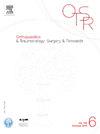New comprehensive score for predicting difficulties in revision total hip arthroplasty
IF 2.2
3区 医学
Q2 ORTHOPEDICS
引用次数: 0
Abstract
Background
Revision total hip arthroplasty (THA) can be complex, and assessing possible difficulties is important to predict the operative time. No simple score for predicting difficulties has been assessed prospectively. We therefore developed an original score for the pre-operative evaluation of extraction and reconstruction difficulties. The objectives of this prospective study were to (1) assess correlations between score values and operative time, (2) determine whether the score predicted the need for revision implants and/or filling material, (3) determine whether the score predicted intra-operative and post-operative complications, and (4) evaluate the inter-observer and intra-observer reproducibility of the score.
Hypothesis
The score is reproducible and correlates well with the operative time, thereby allowing prediction of this parameter before surgery.
Material and methods
A prospective study of 103 revision THA procedures performed between March 2018 and August 2023 was conducted. The primary outcome was operative time and the secondary outcomes were use of a revision implant, use of filling material, and intra-operative and post-operative complications. The score was determined by four observers to allow evaluation of inter-observer agreement. Intra-observer agreement was assessed by having one of the observers determine the score a second time after inclusion of the last patient. The score has a maximum value of 20 and allows classification of the procedure as very difficult, difficult, and moderately difficult.
Results
Mean operative time correlated with the score value: 136.0 ± 33.9 min in the very difficult group, 102.0 ± 34.8 min in the difficult group, and 75.4 ± 65.5 min in the moderately difficult group (p = 0.0002). The score predicted the use of a reinforcement ring (40 procedures: 12/17 [70%], 11/25 [44%], and 17/61 [28%] in the very difficult, difficult, and moderately difficult groups, respectively; p = 0.01) and of a long stem (20 procedures: 8/17 [47%], 7/25 [28%], and 5/61 [8%] patients in the very difficult, difficult, and moderately difficult groups, respectively; p < 0.001). The score did not predict the use of filling material (42 procedures: 10/17 [59%], 9/25 [36%], and 23/61 [37%] in the very difficult, difficult, and moderately difficult groups, respectively; p = 0.250). The score predicted both intra-operative complications (5/17 [29%], 4/25 [16%], and 4/61 [6%] procedures in the very difficult, difficult, and moderately difficult groups, respectively; p = 0.028) and post-operative complications (4/17 [23%], 0/25 [0%], and 6/61 [9%] in the very difficult, difficult, and moderately difficult groups, respectively; p = 0.15). Inter-observer agreement was strong according to Landis-Koch criteria, with kappa values ranging from 0.70 to 0.79 [0.57–0.90]. The kappa value for intra-observer agreement was 0.74 [0.63–0.85].
Discussion
This score predicts surgical difficulties by adding criteria to bone destruction, in contrast to widely used classifications for revision THA. Moreover, the score is reproducible and predicts the operative time, thus potentially playing an important role during pre-operative planning.
Level of evidence
IV; prospective observational non-comparative study
预测翻修全髋关节置换术难度的新综合评分。
背景:翻修全髋关节置换术(THA)可能很复杂,评估可能出现的困难对于预测手术时间很重要。目前尚未对预测困难的简单评分进行过前瞻性评估。因此,我们开发了一种用于术前评估摘除和重建困难的原始评分方法。这项前瞻性研究的目的是:(1) 评估评分值与手术时间之间的相关性;(2) 确定评分是否能预测是否需要翻修种植体和/或填充材料;(3) 确定评分是否能预测术中和术后并发症;(4) 评估评分在观察者之间和观察者内部的可重复性:假设:该评分具有可重复性,并与手术时间密切相关,因此可在手术前预测该参数:对2018年3月至2023年8月期间进行的103例翻修THA手术进行了前瞻性研究。主要结果是手术时间,次要结果是翻修植入物的使用、填充材料的使用以及术中和术后并发症。评分由四名观察者确定,以评估观察者之间的一致性。在纳入最后一名患者后,由其中一名观察者进行第二次评分,以评估观察者之间的一致性。该评分的最大值为 20,可将手术分为非常困难、困难和中等困难:平均手术时间与评分值相关:非常困难组为(136.0 ± 33.9)分钟,困难组为(102.0 ± 34.8)分钟,中度困难组为(75.4 ± 65.5)分钟(p = 0.0002)。该评分预测了强化环的使用情况(40 个程序:非常困难组、困难组和中度困难组分别为 12/17[70%]、11/25[44%]和 17/61 [28%];P = 0.01)和长杆(20 例手术:非常困难组、困难组和中度困难组分别有8/17[47%]、7/25[28%]和5/61[8%]名患者;P 讨论:该评分通过增加骨质破坏的标准来预测手术难度,这与广泛使用的翻修THA分类方法不同。此外,该评分具有可重复性,并能预测手术时间,因此可能在术前计划中发挥重要作用:证据级别:IV;前瞻性观察非比较研究。
本文章由计算机程序翻译,如有差异,请以英文原文为准。
求助全文
约1分钟内获得全文
求助全文
来源期刊
CiteScore
5.10
自引率
26.10%
发文量
329
审稿时长
12.5 weeks
期刊介绍:
Orthopaedics & Traumatology: Surgery & Research (OTSR) publishes original scientific work in English related to all domains of orthopaedics. Original articles, Reviews, Technical notes and Concise follow-up of a former OTSR study are published in English in electronic form only and indexed in the main international databases.

 求助内容:
求助内容: 应助结果提醒方式:
应助结果提醒方式:


